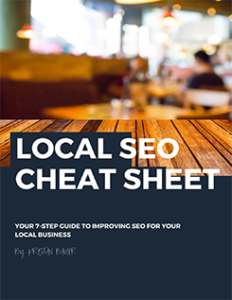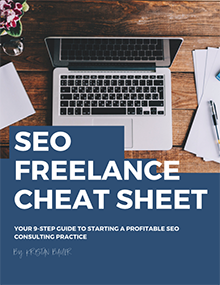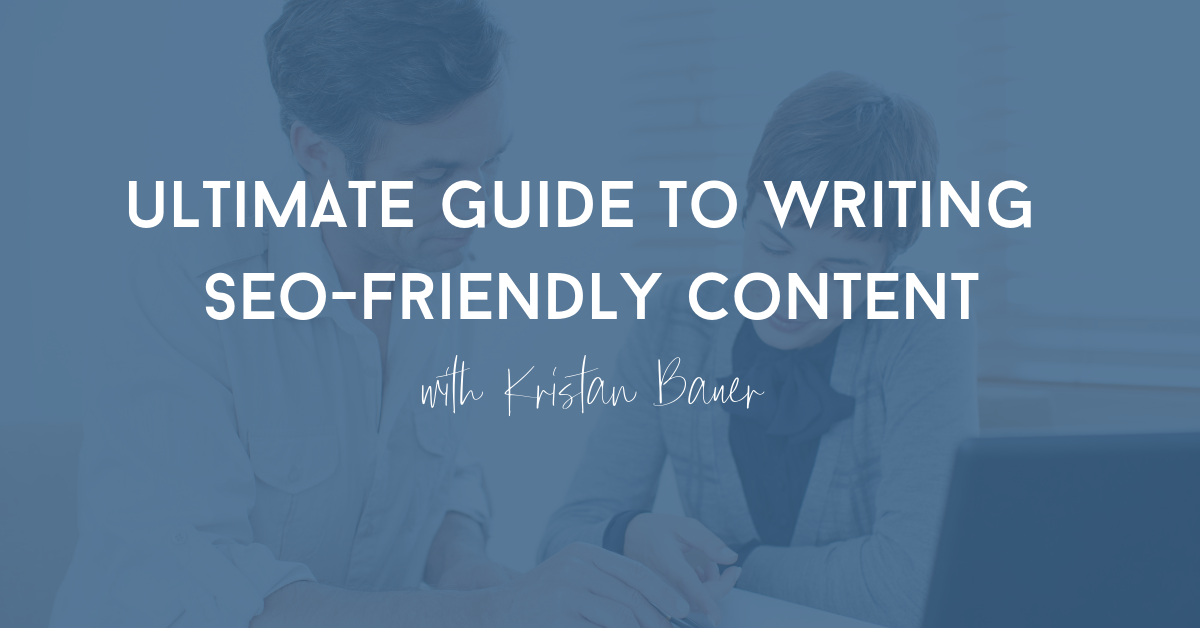
How to Write SEO-friendly Content
Ultimate Guide to Writing SEO-friendly Content
The ultimate goal of search engine optimization (SEO) is to have your content discoverable for users via search engines such as Google and Bing. To accomplish this, learning how to write SEO-friendly content is critical.
Writing SEO-friendly content includes understanding your audience, carefully selecting your content topics, and crafting high-quality content for your users. Once your content is written, there are tactical steps to further enhance your content for SEO, including optimizing meta attributes, heading tags, and images.
Here are some important steps on how to write SEO-friendly content:
- Understand your audience.
- Write for users, not search engines.
- Write unique title tags and meta descriptions.
- Use relevant headlines and subheaders.
- Include internal and external links.
- Optimize image attributes.
- Make content shareable (via social sharing and Open Graph protocol).
Understand Your Audience
Developing the right content for SEO all starts with understanding your audience. Understanding who you’re trying to reach, their interests, and what they search for is fundamental for search engine optimization (SEO) and crafting your online content.
Do Keyword Research
An informed keyword strategy can help align your content to relevant terms and help you discover new content opportunities. Understanding the queries your audience is using starts with a keyword research strategy.
Before you begin writing web content, consider some of the key terms that relate to the topic you wish to write about. Keyword research starts with a question such as, “What is my audience searching for?”
After brainstorming what a user might search, enter those keywords into keyword research tools to discover new opportunities or help prioritize your initial list. Some widely used keyword research tools include Google AdWords Keyword Planner, Google Trends, SEMrush, and Moz Keyword Explorer.
See the keyword research tools section below for more detailed information.
Research Competition
Understanding what content your competition is creating is helpful to identify content gaps for your site. Additionally, searching for the phrases you’ve brainstormed in keyword research will help identify the types of content your ranking competitors are creating.
Reviewing the top-ranking content for a term you’re targeting will help prioritize certain content mediums (such as video or infographics) or content length. If all the ranking competitors have content that’s more than 1,000 words, then you should consider a more in-depth article versus a light blog post.
Discover Useful Topics
Identifying the right kind of topic is crucial in reaching the right audience and writing SEO-friendly content. This starts with knowing your audience, their questions, and keyword research.
Once you have an identified topic that you want to write about, you can discover new article topics through keyword research tools, competitive insights, and related searches.
For example, I want to write about “stand up paddle yoga.” By searching for this topic, I can see that the majority of posts are about specific poses, local classes, or benefits.
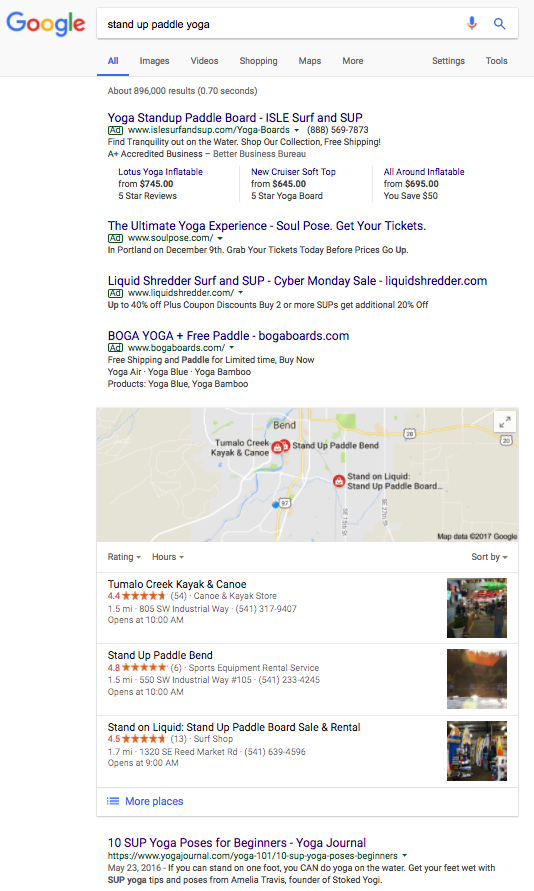
Source: google.com
Additionally, looking at the related searches section will help uncover new topics related to “stand up paddle yoga” or “sup yoga.”
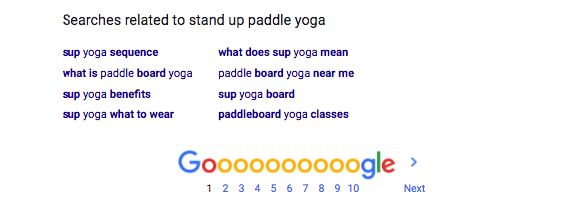
Source: google.com
Another great tool for identifying popular topics is BuzzSumo. Enter your topic, and you’ll discover the most shared content and the top influencers within that topic, the type of content (such as video like the SUP Magazine piece below), and whether it was successful in driving backlinks.
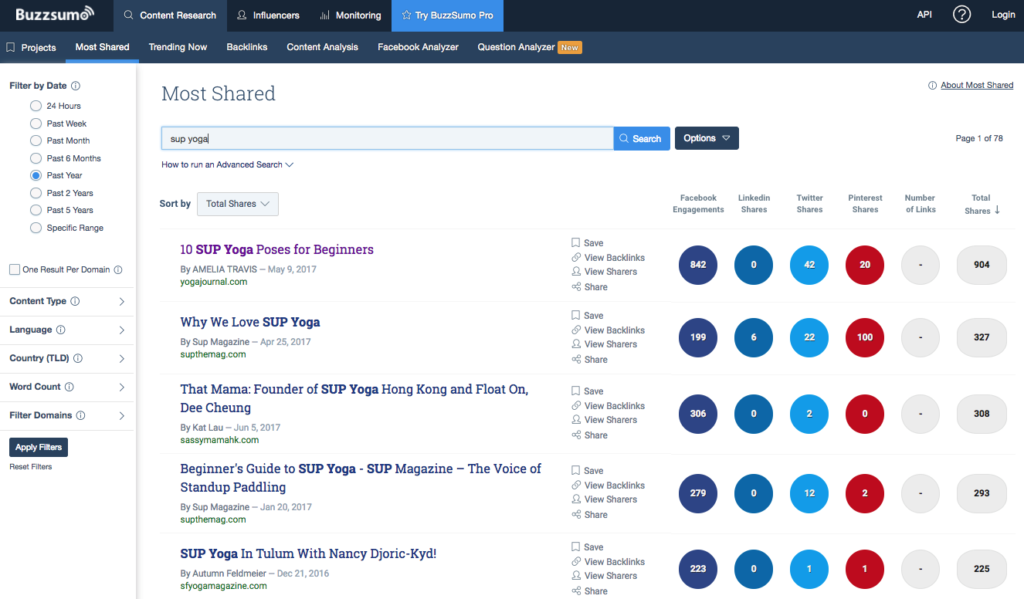
Source: http://buzzsumo.com/
Write for Users, Not Search Engines
When writing content, users and their experiences should come first while SEO considerations should be incorporated naturally within the copy. Keeping that mindset will ensure that your content aligns with the ultimate goal of content development: providing helpful information to your customers (current and future).
High-quality Content
Content quality is key to be successful with search engine optimization efforts. Content is one of the top three ranking factors for Google and can be broken down into a myriad of other micro-ranking factors, including content freshness, content length, and keyword usage.
Additionally, quality content is about creating a great user experience and answering the user’s question. High-quality content is also helpful in garnering backlinks (external links from other sites), which is also among the top three ranking factors.
One of my favorite examples of high-quality content can be seen in The New York Times article on the Tunnel Creek avalanche around Stevens Pass, Washington.
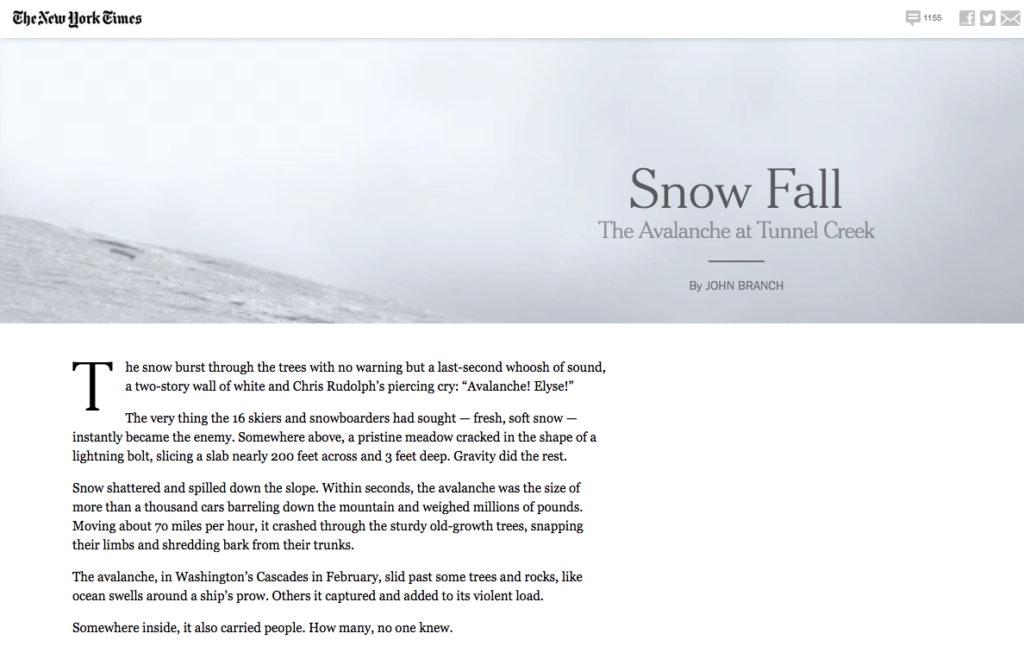
Source: http://www.nytimes.com/projects/2012/snow-fall/
This article created an excellent multimedia experience and captivated readers’ attention. It also drove more than 1,100 comments; 200,000 backlinks; and 110,000 social shares. Content like this is not easily created but can pay off in dividends for brand reach and customer engagement.
Content Length
Numerous industry studies have shown that there is a high correlation between long content and higher rankings. A recent analysis by Backlinko showed that the average Google first page result contains almost 1,900 words.
To get a better idea of existing content, try researching competitive results ranking for your target query and evaluating the type of content they use and the depth of information provided. This will provide a gauge for how long your article should be to be competitive.
A good rule of thumb is setting a minimum word count for blog articles between 400 and 600 words and then adjusting based on competition or content topic.
Keyword Usage
Choose three to five keywords to incorporate into your content that surrounds a central theme. Focus on a primary keyword and its related variations. A good strategy is to incorporate one of the high-volume keywords and add variations of that term throughout the content.
For instance, you might choose “sup yoga” as the keyword you are focusing on for a page. You might then add related keyword variations such as “stand up paddle yoga” or “stand up paddleboard yoga” into the article. However, be sure these query variations occur naturally and make sense for the page.
Refer to keyword research when crafting elements of a page that are important to SEO, such as page titles, meta descriptions, and page content.
Write Unique Title Tags and Meta Descriptions
A page’s title tag and meta descriptions are the snippet of text that shows in search results. Both elements are extremely important for click-through rate (CTR) and conveying the main topic of the page.
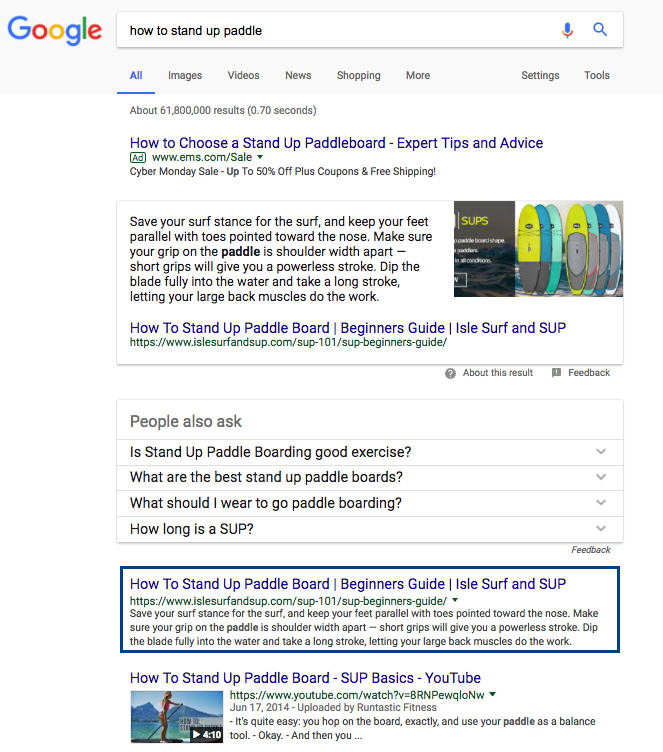
Source: google.com
Title tags are direct scoring factors for ranking and should be chosen carefully. Think about the target keywords chosen for the page, and integrate them within the title tag, prioritizing the most important keywords first.
Title tags should be succinct and compelling with approximately 60 to 70 characters (600 pixels) shown in search results. Keywords that are cut off in search results (beyond the 600 pixels) will still count toward your ranking but can impact CTR.
Meta descriptions are not direct scoring factors but heavily influence CTR, which is an indirect ranking factor. Similarly with page titles, use the target keywords and variations within the meta description.
Meta descriptions can be written in complete sentences and can be 300 to 320 characters in length (Google recently expanded the meta description field). I also like to start meta descriptions with a call to action (CTA), if relevant.
If you use WordPress, I highly suggest the Yoast SEO plugin, which allows for completely customizable title tags and meta descriptions.
Use Relevant Headlines and Subheads
Heading tags help structure a page semantically for both users and search engines. Heading tags provide a frame of reference for users and are useful for targeting key terms on a page.
In the page’s code, you can markup heading tags as h1, h2, h3, etc. Although all heading tags should be carefully selected, the most important heading tags for rankings are h1 and h2.
When optimizing your h1 heading tag, consider the key elements you’re trying to optimize the page for and what makes sense for users when they land on the page. Subheadings can reflect subtopics for the article and reinforce related keywords.
Typically, with blog articles, the article title will be the h1 heading tag. Following your h1 heading tag, subheadings should be designated as h2 heading tags and reflect related topics within the article.
For instance, if I’m writing about a beginner’s guide to SUP yoga, my subheadings might be about “SUP Yoga Benefits” or “What to Wear for SUP Yoga.” Or the REI example below with an h1 heading tag of “Stand Up Paddle Boarding (SUP) Basics” and relevant subheadlines to support the article’s content.
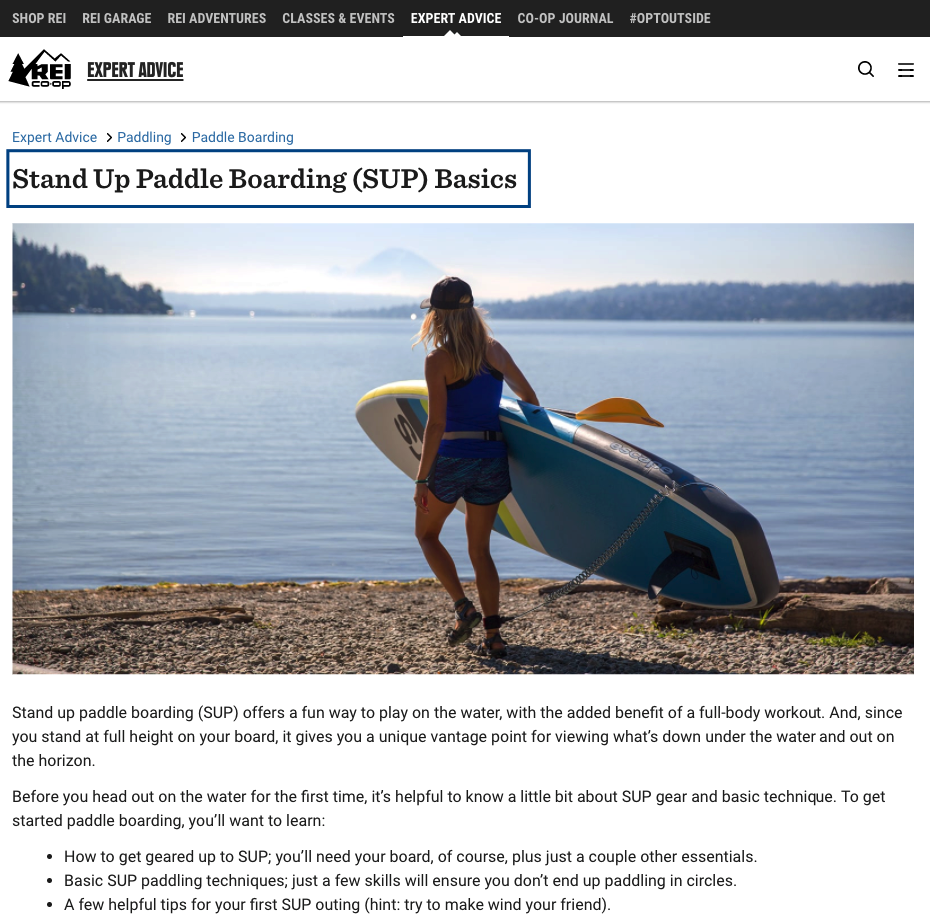
Source: https://www.rei.com/learn/expert-advice/paddleboarding.html
Include Internal and External Links
Including relevant links throughout content can send important quality signals and add relevancy. This includes both internal and external links.
Internal linking sends strong signals to search engines regarding top content within a site and can consist of links within site navigation, footers, breadcrumbs, and content. Internal links indicate to search engines what keywords are associated with each page through the use of anchor text and are important crawl signals.
Contextual links (links embedded within the text on the page) are important because they provide the best contextual clues around the anchor text and relay that onto the linked page. It is very important that these links are descriptive and link to relevant content. A good rule of thumb is one link per 100 words.
Here’s a great example of an article with internal and external contextual links: “10 Reasons You Should Try Yoga on a Stand Up Paddleboard” from HuffPost.
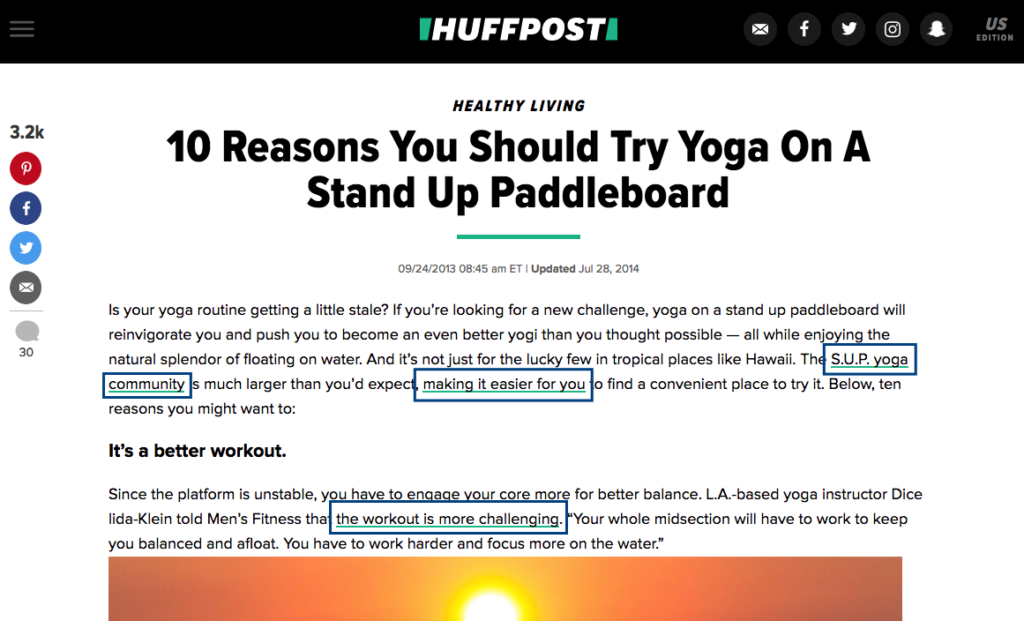
Source: http://www.huffingtonpost.com/2013/09/24/stand-up-paddleboard-yoga_n_3973574.html
Adding external links to authoritative sources has also been proven to increase the SEO value of a page. A study by Reboot Marketing hypothesized that Google can determine the authority of a page or website based on what other authority sources it associates itself with (by linking to them).
Optimize Image Attributes
Images have been shown to increase customer engagement and are another contextual element that can be optimized for organic search. Specifically, search engines “read” the alt attributes (“alt text”) and image file names.
Additionally, if an image is properly named and optimized, it’s more likely to show up in image searches for relevant queries.
Typically, most content management system (CMS) platforms will have an image alt text field that can be optimized. Image alt text should be a short, descriptive phrase of the image. Image file names should be saved before uploading photos and should also be a short, descriptive phrase separated by hyphens.
Here’s an example of how to optimize an image from Yoga Journal’s article “10 SUP Yoga Poses for Beginners.”

Source: https://www.yogajournal.com/yoga-101/10-sup-yoga-poses-beginners
Current alt text: “Tips SUP StokedYogi”
Updated alt text: “Women doing SUP yoga”
Current image file name: tips-sup-stokedyogi.jpg
Updated image file name: women-sup-yoga.jpg
Another item to consider when optimizing images is specifying the size and saving for the web (via Photoshop). Images can often be large resources and cause a page to load slowly. Saving for web (70 to 80 percent of original is typically OK for high-resolution photos) and sizing pixels appropriately can significantly improve page speed.
Make Content Shareable
Once you create great content, ensuring that it’s socially shareable is important. This includes having your social sharing links visible and specifying Open Graph protocol tags on your site.
There are many different tools and plugins that provide accessible social sharing buttons. AddThis is a super simple plugin that allows you to customize the location of your social sharing buttons, including on the side, floating, or integrated within the article.
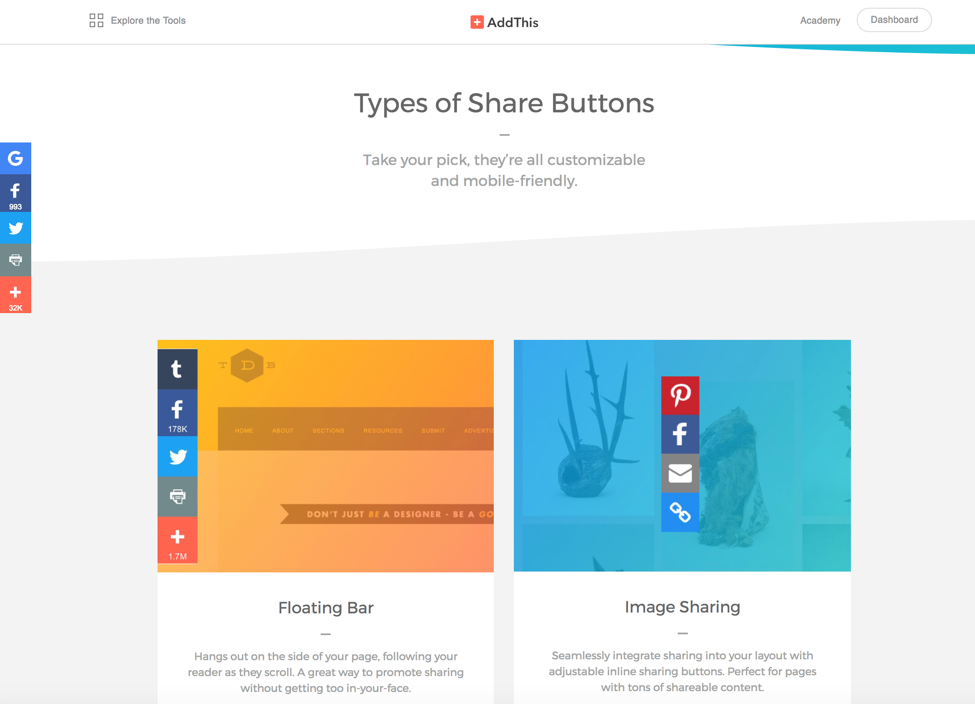
Source: https://www.addthis.com/get/share
Using Open Graph protocol tags ensures that every article or page is properly formatted for social sharing, including images, description, and title. This is metadata that’s included in the source code of a page and easily available via plugins.

Source: http://ogp.me/
Tools for Writing SEO Content
Having the right SEO tools is essential for doing proper research, including keyword research, competitive analysis, and content optimization. Below outlines some of my favorite tools used for keyword research.
Keyword Research
Google AdWords Keyword Planner
Google’s AdWords Keyword Planner is helpful for prioritizing keywords and discovering new queries. The Keyword Planner provides monthly search volume trends and competition scores for paid advertisers.
After brainstorming what a user might search for, enter those keywords into the Keyword Planner tool. You can analyze the search volume for the terms you entered as well as discover new keywords with suggested keywords and ad group ideas.
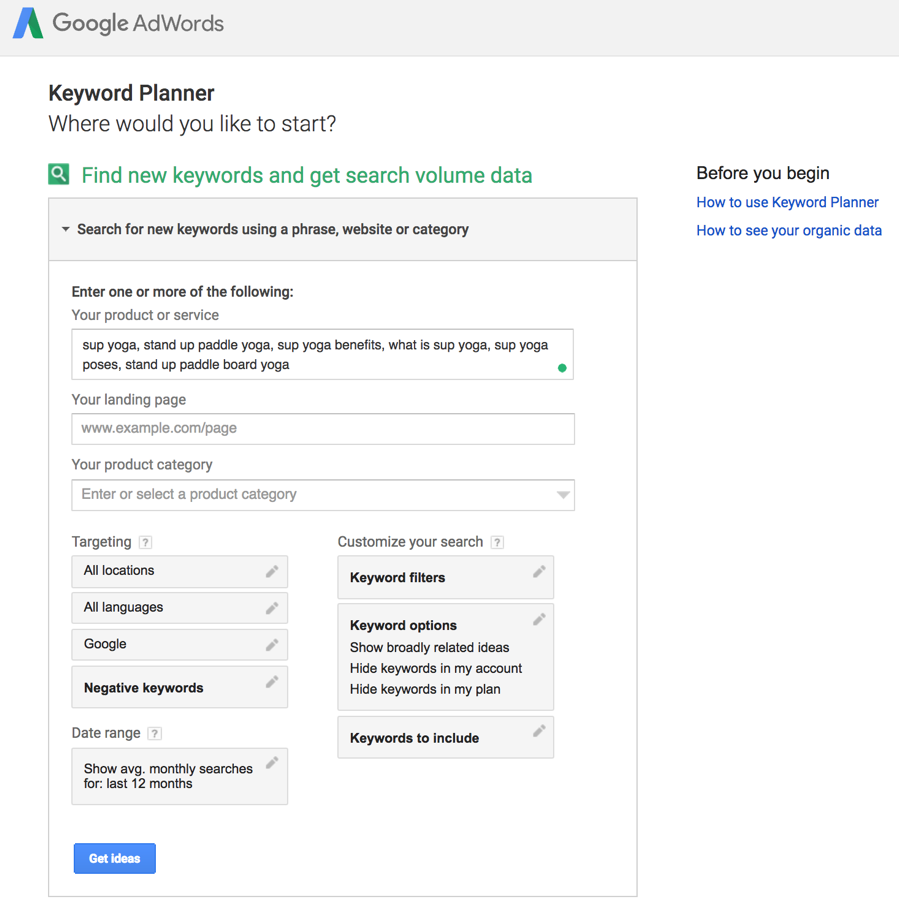
Source: https://adwords.google.com/ko/KeywordPlanner/Home
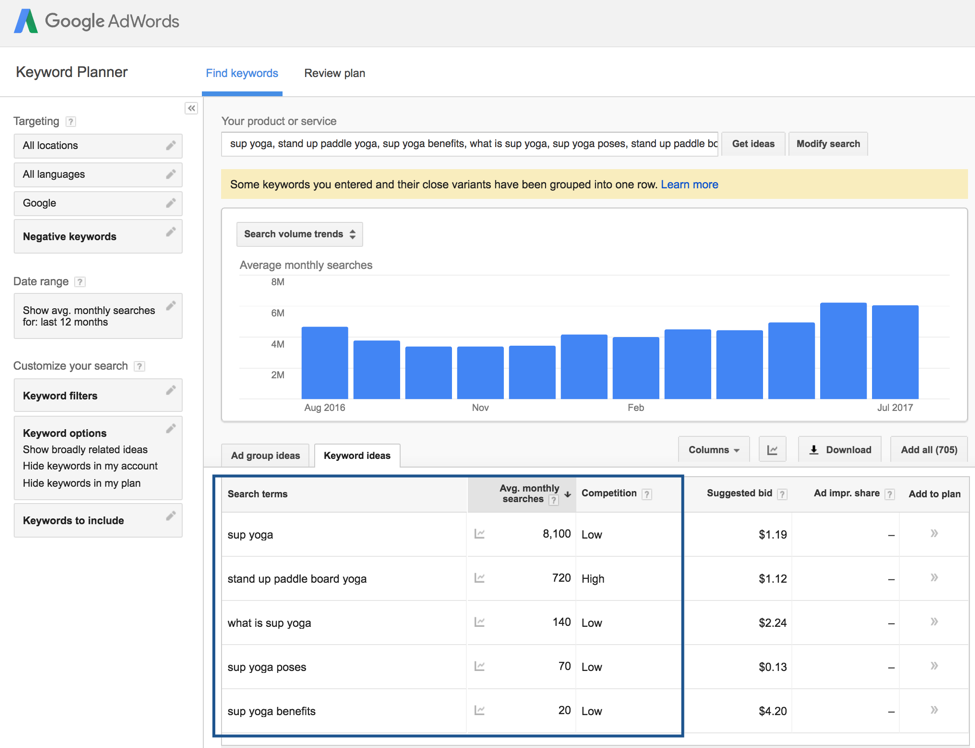
Source: https://adwords.google.com/ko/KeywordPlanner/Home
Unfortunately, Google recently updated search volume to only provide exact monthly search volume for paid customers and provides a very unhelpful range for free. I suggest getting access to a paid account or periodically running a small paid campaign to gain access to the exact match volume if you plan to use this heavily.
SEMrush
SEMrush is one of my favorite tools for keyword research, competitive research, and identifying SEO opportunities. SEMrush provides a significant amount of free information, but there is also an option for paid subscribers who use this tool frequently that provides more data.
You can search SEMrush by keyword phrase, domain, or URL to see organic traffic and backlink insights. SEMrush can provide competitive insight into popular terms competitors are ranking for and help discover gaps in content.
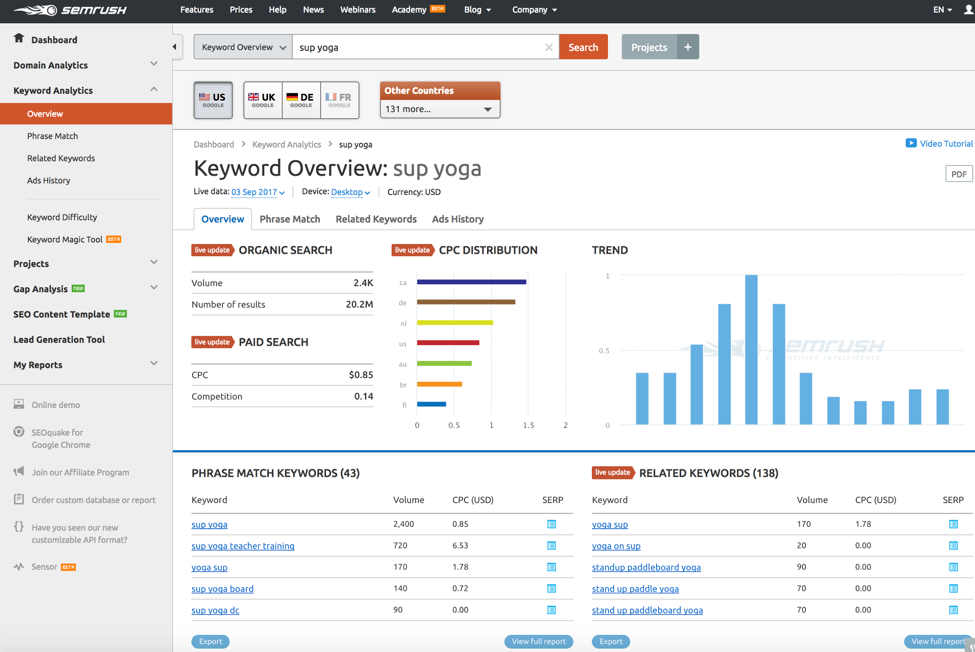
Source: https://www.semrush.com/
Google Trends
Google Trends is helpful if you’re on the fence about which keywords might be the best. Google Trends provides a relative measure of search popularity (Google Trends contains high-level popularity metrics, not specific monthly search volume).
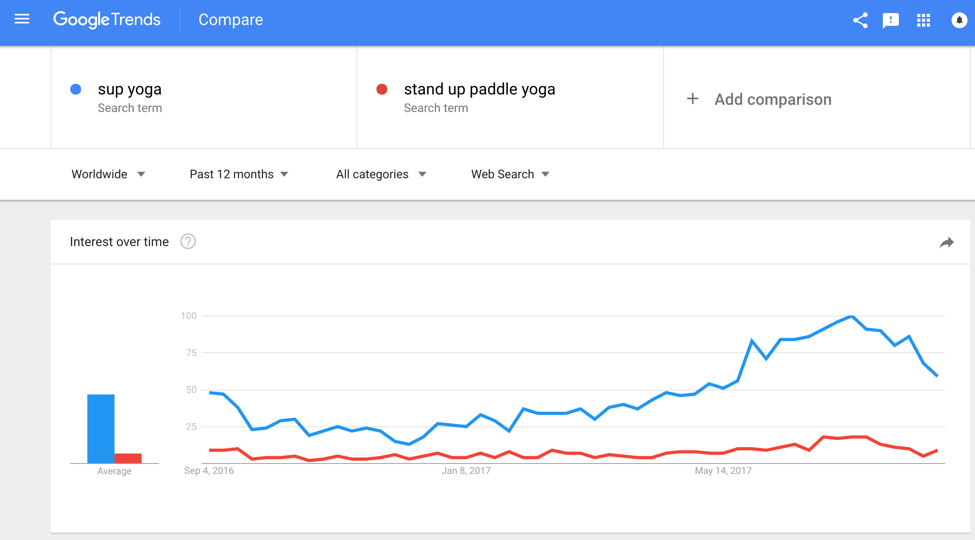
Source: https://trends.google.com/trends/
Google Trends is helpful to identify keywords on the rise or choose between target keywords. Based on the chart above, “SUP yoga” is the more popular phrase.
Hopefully, this guide has been helpful in outlining how to identify new content topics and learning how to write SEO-friendly content. I’d love to hear from you if you have any additional questions or any struggles in creating SEO-friendly content. Please lease a comment below!
Updated: May 20, 2020
Kristan is an independent consultant with 15 years of experience in the SEO industry. Kristan previously founded the award-winning SEO agency Conifr. She’s worked in agency and in-house SEO leadership positions, most notably as the SEO Director at Zillow Group, overseeing a channel that received over one billion web visitors a year. Kristan is a freelance SEO consultant who built and sold a seven-figure agency and now enjoys helping others develop their freelance business.






